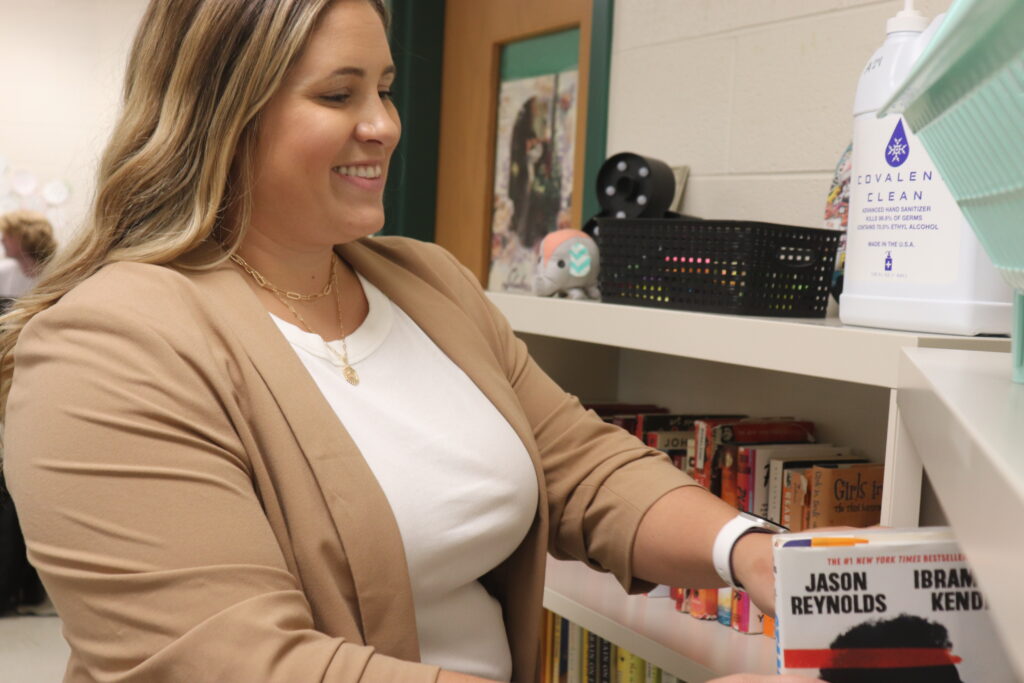Teachers incorporate diverse selection of books into classroom libraries
Ava Yungbluth | The Chronicle

By diversifying their bookshelves, teachers are showing their students how to read between the lines.
All across the Mason City Schools (MCS) district, books have become more varied along with the students that read them. Inclusive excellence, which is an aspect of superintendent Jonathan Cooper’s “three big rocks”, centers around valuing, engaging and including a diverse population of students and staff members. As this is promoted at MCS, teachers are acting upon the realized importance of diversifying their bookshelves.
Many Mason teachers are trying to show their students that their stories matter. Freshman English teacher Sarah Boselovic helps students to not just let people know their stories, but to look beyond their own stories and place themselves in the shoes of characters in their books. She said she relates reading to empathy and that the more someone reads, the more empathetic they become towards the people around them. Boselovic believes that, although English skills are important, it is being a better person that truly counts.
“I hope these books expose them to more than they’re aware of,’’ Boselovic said. “If you can build empathy from a person’s experience in a fiction or nonfiction book, you’re going to grow as a human.”
Boselovic has also been encouraging her students to read more nonfiction, a goal that she has been working towards herself. In this goal, she said has been covering topics such as race and multiculturalism, providing books in her classroom library that offer multiple perspectives on the world that students are growing up in.
“It’s eye-opening, in a way,” Boselovic said. “It’s not the end all be all of that topic, but I think reading as much as you can from a variety of people on one topic is what builds our empathy, our knowledge and our understanding of the world around us, instead of just taking one person’s side of the story.”
English isn’t the only dialect filling the shelves, with language variation being another represented facet of Mason’s newfound literature diversity. Spanish teacher Travis Murray stocks his classroom with new books consistently to align his collection with the identities of the current generation of students. He finds his books on social media and from other teachers. Like Boselovic, he wants to find as many books as he can that students can relate to.
“I really tried to have books that students will be able to see themselves in,” Murray said. “[They can see themselves] in the characters, the context, the setting and also the family and background and all the different ways that a student might be able to say, ‘I connect with this character.’”
One of Boselovic’s students, freshman Nadia Markich, feels that she has been more exposed to diverse literature in her language arts classroom. As an avid reader, she said she appreciates the new and different books she and her classmates are shown.
“I think that Ms. Boselovic does a good job of allowing us to experience diversity in books in her classroom,” Markich said. ”You are able to learn about some more personal things that you may never have to go through like the author did, and it gives you an experience you can’t get anywhere else.
When teenagers see themselves or their identity in a character, they often feel a sense of comfort in the knowledge that they are not alone. Noticing this pattern, Boselovic said she values interaction with her students and likes asking them about what they are reading or about their lives. This way, she can find similar novels that may be of interest to those particular students.
“I really try to make sure that the authors represent different backgrounds or that their characters represent different backgrounds,” Boselovic said. “I find students tell me all the time that it’s easier to read when they can relate to a character.”
While fictional novels often serve as the main source of parallelism between characters and modern-day teenagers, biographies allow students a peek into the lives of real people–giving them an opportunity to connect the text with the real world. Autobiographies, like Anne Frank’s The Diary of a Young Girl, combine the author’s voice with character connection. Markich appreciated reading Frank’s novel because she was “able to see her emotions and thoughts,” ultimately making her “more aware” of the situations of other people throughout history.
To make it easier to keep track of different genres and authors, teachers like fifth-grade language arts teacher Amanda Schreiber have scanners, such as the app Booksource. Apps and forms such as this one allow teachers to see what books they have and figure out what they still need. It provides charts and graphs as a visual example as well to better help teachers find balance in what forms of literature they offer. Schreiber sees these apps or websites as helpful assistants, allowing her to “keep [her] collection growing and growing to meet needs.”
Above all else, teaching students to be better people is the top priority for Boselovic. By keeping her classroom library diverse, she can create a space where students can openly learn about stories different from their own.
“That’s kind of the goal of my classroom,” Boselovic said. “English is so connected to the world we live in that I just kind of want my students to be better people at the end of the day and at the end of the school year.”
Photo contributed by Ella Rubsam
